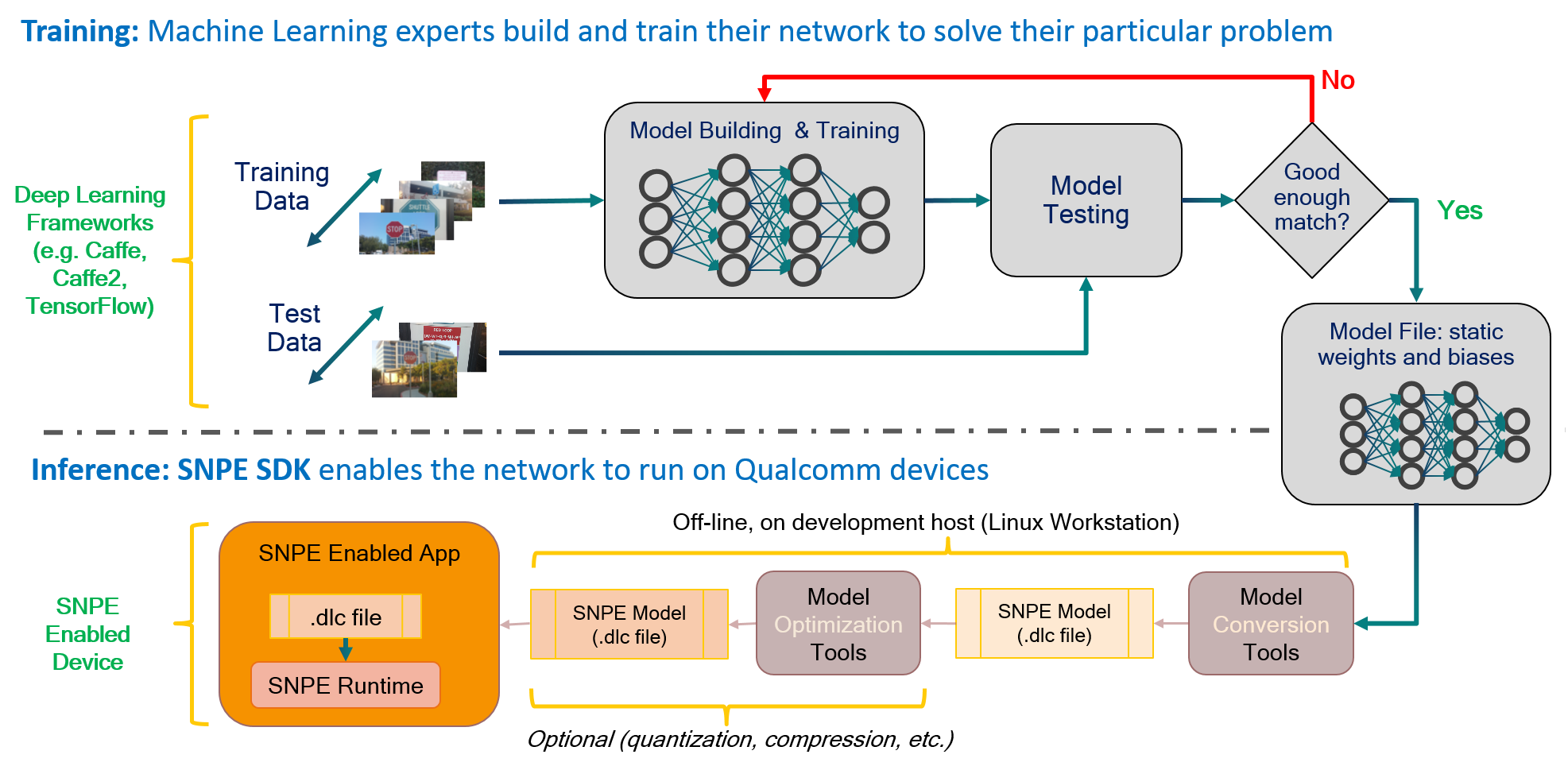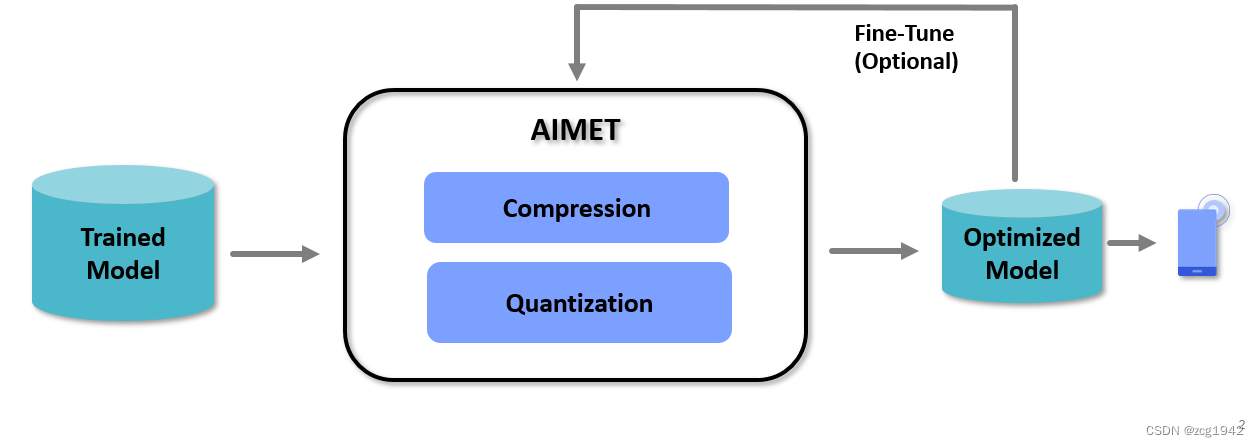量化解決的是訓練使用的浮點和運行使用的硬件只支持定點的矛盾。這里介紹一些實際量化中使用到的工具。
SNPE簡介
The Snapdragon Neural Processing Engine (SNPE)是高通驍龍為了加速網絡模型設計的框架。但它不只支持高通,SNPE還支持多種硬件平臺,ARM平臺、Intel平臺等。支持的深度學習框架也有包括Caffe、TensorFlow和ONNX等。
SNPE可以前向運行模型,但需要先將模型轉換為Deep Learning Container (DLC) file才可以加載進SNPE中。
CPU支持支持雙精度浮點和8位量化的模型,GPU支持混合精度或者單精度浮點,數字信號處理器DSP就只支持支持8位整形。DLC進一步進行8bit量化才可以運行在Qualcomm?Hexagon?DSP上。
下圖是典型的workflow:
 ?
?
上圖的上半部分是我們熟悉的模型浮點訓練,當模型效果達到預期之后,模型參數固定下來,然后轉換成dlc,dlc再經過壓縮,量化等操作,最后運行在SNPE中。
SNPE安裝及命令
下載SNPE壓縮包,版本號與高通芯片有關,主流是2.13,還有2.17,2.22等。在壓縮包的docs文件夾里面有官方html文檔。
source ./bin/envsetup.sh,激活snpe環境。sh ,bash ,./,?source的作用都是執行腳本。然后就可以在終端中調用snpe指令了:
轉換dlc
以TensorFlow 為例,模型文件可以是pb file或者checkpoint+meta,調用SNPE轉換指令時給定模型路徑和輸入尺寸,最后一層節點名字,就可以得到dlc文件:
snpe-tensorflow-to-dlc --input_network $SNPE_ROOT/models/inception_v3/tensorflow/inception_v3_2016_08_28_frozen.pb \--input_dim input "1,299,299,3" --out_node "InceptionV3/Predictions/Reshape_1" \--output_path inception_v3.dlc如果是pytorch框架得到的模型,使用snpe-pytorch-to-dlc,serialized PyTorch model into a SNPE DLC file。
更一般地,不管什么框架,都可以先將模型轉換為onnx格式。ONNX(Open Neural Network Exchange)是一種開放式的文件格式,專為機器學習設計,用于存儲訓練好的模型。它使得不同的深度學習框架(如Pytorch,MXNet)可以采用相同格式存儲模型數據。onnx轉dlc使用命令snpe-onnx-to-dlc。
解析dlc:
snpe-dlc-info -i ./xxxx.dlcdlc量化:snpe-dlc-quantize。
[ --input_dlc=<val> ]Path to the dlc container containing the model for which fixed-point encodingmetadata should be generated. This argument is required.[ --input_list=<val> ]Path to a file specifying the trial inputs. This file should be a plain text file,containing one or more absolute file paths per line. These files will be taken to constitutethe trial set. Each path is expected to point to a binary file containing one trial inputin the 'raw' format, ready to be consumed by SNPE without any further modifications.This is similar to how input is provided to snpe-net-run
application.
[ --enable_htp ] Pack HTP information in quantized DLC.Snapdragon Neural Processing Engine SDK: Tools
run on linux
cd $SNPE_ROOT/models/alexnet
snpe-net-run --container dlc/bvlc_alexnet.dlc --input_list data/cropped/raw_list.txtrun on android target
推lib下面對應架構的所有so
推lib/dsp下面的so
推bin里面的snpe-net-run
AIMET簡介
剛才提到的量化其實是后量化,要想實現量化感知訓練QAT,需要使用AIMET(AI Model Efficiency Toolkit),AIMET也是高通提高的工具,可以實現量化和壓縮。
AIMET是一個庫,可以對訓練好的模型進行量化和壓縮,從而在保證精度損失最小的情況下縮短運行時間,減輕內存壓力。
 ?
?
雖然是在訓練過后再使用AIMET,但它不是簡單地轉化為dlc,而是也有一個訓練的過程,這個過程盡量縮小與浮點模型的誤差。
AIMET實例
PTQ
參考github上面的文檔。AIMET PyTorch AutoQuant API — AI Model Efficiency Toolkit Documentation: ver tf-torch-cpu_1.31.0
即便是后量化也有很多方法組合,需要一些專業的分析。AIMET 提供了AutoQuant 這樣的接口,可以自動分析模型,選擇最合適的后量化方法。用戶只需要指明能接受的精度損失就可以了。
核心是實例化一個AutoQuant類:
auto_quant = AutoQuant(model, # Load a pretrained FP32 modeldummy_input=dummy_input, # dummy_input 是一個隨機數組,只要維度符合輸入就行。data_loader=unlabeled_imagenet_data_loader, eval_callback=eval_callback) # 統計準確率使用默認值初始化后開始量化:
auto_quant.set_adaround_params(adaround_params)
model, optimized_accuracy, encoding_path = auto_quant.optimize(allowed_accuracy_drop=0.01)
print(f"- Quantized Accuracy (after optimization): {optimized_accuracy}")注意,auto_quant.optimize會返回三個值,分別是model,精度,和encoding path。encoding path以類似json的格式記錄了每一層的名稱,位寬,最大值最小值,offset,scale,還有是否是symmertic。
這里的offset,scale應該就對應上一篇量化中提到的step和zero point。
QAT
參考文檔。AIMET PyTorch Quantization SIM API — AI Model Efficiency Toolkit Documentation: ver tf-torch-cpu_1.31.0
關鍵是構建QuantizationSimModel:
sim = QuantizationSimModel(model=model,quant_scheme=QuantScheme.post_training_tf_enhanced,dummy_input=dummy_input,default_output_bw=8, # activation quantizations的bitwidthdefault_param_bw=8) # parameter quantizations的bitwidth真正的QAT也只用一行代碼完成:
ImageNetDataPipeline.finetune(sim.model, epochs=1, learning_rate=5e-7, learning_rate_schedule=[5, 10], use_cuda=use_cuda)也可以把sim當成一個正常的模型,然后使用常規的torch的梯度更新的訓練方法進行訓練。
reference:
基于CentOS更新 glibc - 解決 `GLIBC_2.29‘ not found-CSDN博客
MVision/CNN/Deep_Compression/quantization at master · Ewenwan/MVision · GitHub
模型量化了解一下? - 知乎
Snapdragon Neural Processing Engine SDK: Features Overview
Tensorflow模型量化(Quantization)原理及其實現方法 - 知乎
GitHub - quic/aimet: AIMET is a library that provides advanced quantization and compression techniques for trained neural network models.AI Model Efficiency ToolkitGitHub - quic/aimet: AIMET is a library that provides advanced quantization and compression techniques for trained neural network models.


Python3 接口自動化測試,測試結果發送郵件)













)

)
